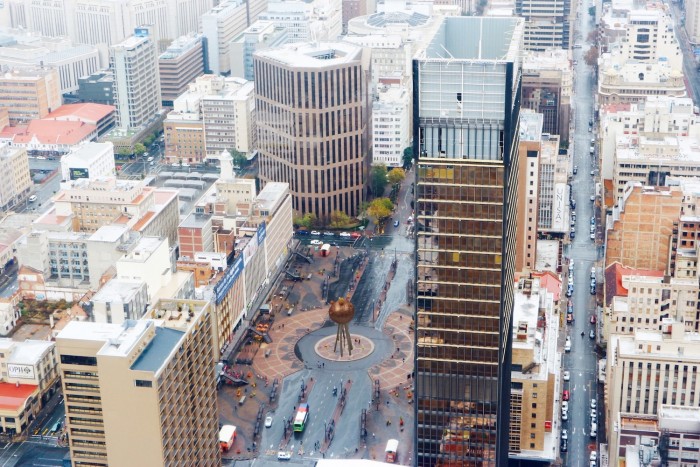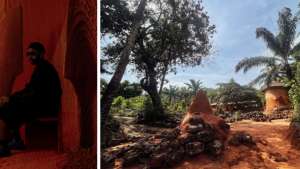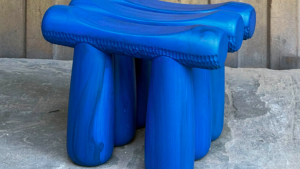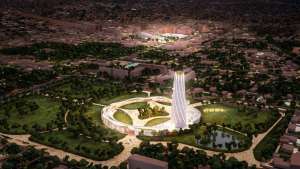With an academic background that includes social sciences, curatorship and architecture, Michelle Mlati's trajectory is an interesting one; more so for the way her current work dabbles in these areas simultaneously.
Describing herself as an afrofuturist critical spatial designer, Johannesburg-based Mlati’s practise investigates elements of the city, from sustainability through to social dynamics, architecture to aural and visual cultures.
It was while completing her Honours project at Michaelis School of Fine Art that she started addressing spatial and architectural issues. The project explored gentrification in Cape Town and London. “The content of my curatorial work was a response to communities being displaced from significant cultural venues and spaces critical for sustaining their livelihoods,” she says.
She imagined spaces that were created in a speculative future where people had been evicted and all that remains are their voices. This prompted users of the space to reflect on present spatial issues in a future spatial context. Mlati says this was a defining moment for her in that she realised that her creative practise would be grounded in spatial invervention and socio-political issues.
A look at most of the world’s top cities and their development paths will be incomplete without acknowledging the scourge of gentrification. It brings to the fore the political nature of architecture more plainly than anything in recent history.
During her project, Mlati’s experience confronting affected residents alongside South African council members implicated in the displacement, gave her a greater sense of the way spaces are tied up in politics. On the other hand, councillors interviewed in the UK advocated for those being displaced. This disparity is interesting, but points to the gravity of political will and intervention in the make-up of our spaces.
She reminds me that architecture and curatorship are not so far removed after all. They’re both spatial practices. “They both have the power to create meaning using space.”
Her Master’s project Green-Smart City is a spatial critique of the city of Johannesburg, investigating the exclusivity of green spaces, and the socio-political context surrounding them. It was led by a contemplation on why the more affluent suburbs of the city tended to be greener, while the inner city and surrounding townships (predominantly occupied by black people), were defined by concrete and ‘brown’ spaces.
She staged an intervention to investigate this more closely. It involved planting vegetation in the township of Dunusa, alongside a solar powered artwork. Mlati found that the very establishment of the intervention encouraged public participation, but what was of more interest was people's responses to the intervention over time.
Day two saw the artwork removed, while on day three, the plant attracted passers-by to engage in conversation, signalling to the “vegetation’s potential for placemaking and to serve as a resting place for city inhabitants.” An unforeseen outcome, on day four, just like the artwork, the plant had been removed altogether, and replaced with waste of all sorts.
While her intention was to critique the lack of vegetation in urban spaces, she was left with alternative conclusions, among them is that theft is an unavoidable tragedy in these spaces. She says it highlighted “many systemic issues in the inner city which might be attributed to unemployment and people willing to do anything to get a quick buck.”
In this we see again how social context is intertwined in the way spaces are formulated. The damning takeaway from this intervention for Mlati was that creating beautiful and healthy environments for those not economically uplifted presents its own set of unique challenges. It also opens up the discussion further to broader issues pertaining to how we get beyond economic upliftment. Quite a departure from the initial investigation of green urban spaces.
This leads the conversation on the idea of the afrofuturist city. The world has recently experienced a surge in pop culture narratives drawn from and embracing this concept. It’s essentially a construct through which black bodies navigate rapid social change, a freedom from the history of oppression and marginalisation, according to academic Reynaldo Anderson.
Similarly, Mlati sees the afrofuturist city as a way to overcome the spatial issues inherent in the social and physical make-up of our places.
“I think of it as a city that fills a physical and socio-spatial gap in the lives and livelihoods of black people who feel like outsiders in spaces that were not created for and by them, which aims to create a more inclusive city that ensures their survival in an increasingly globalising world.”
Given South Africa’s brutal past, defined by colour, race, hate, segregation, this notion becomes increasingly important and urgent. It’s evident down to the construction of buildings that specifically serve the goal of segregation. For example, the research of Ilze Wolff looked at the ways a Cape Town landmark building, the Rex Trueform factory, is entangled in a greater conversation of race, gender and society.
This is the kind of history Mlati wants to rewrite:
“It is about spatially rewriting the city to not only mitigate apartheid spatial legacies that continue to spread in perpetuity in relation to other matters, such as climate change, but one that transforms with evolving black culture.”
Read more:
On designing spaces with people's mental health in mind
Designing for urban mobility means learning from the past and predicting for the future
Ilze Wolff on creating an activist and public culture around architecture










